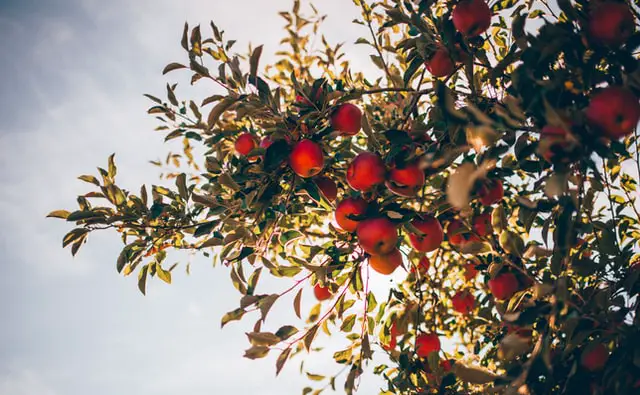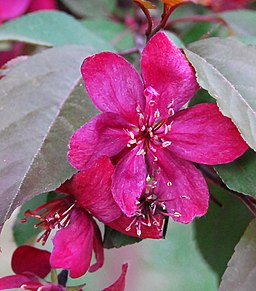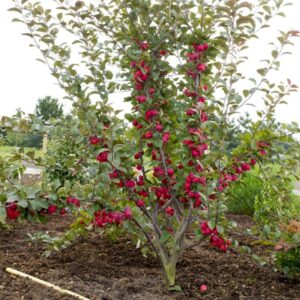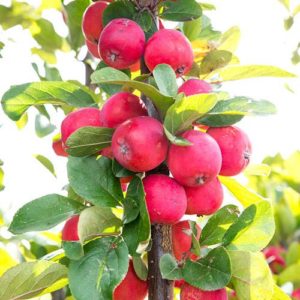With dwarf crab apple trees you can have both decorative and fruit bearing trees that can produce good amounts of fruit. Whether you want an easier tree to maintain or only have access to a small spot, a dwarf crab apple tree will be ideal. Once picked you can make as much crab apple jelly and jam as you like.

With stunning displays of white and pink blossom in spring, you’ll be the envy of all your neighbours. Stunning crab apples emerge in the autumn when your tree will be filled with reds and oranges. Crab apples are ideal to use in sauces and jellies, they aren’t suitable straight from the tree.
Dwarf crab apples will stay at a height of around 5ft to 10ft which is a lovely size for the garden. Miniature crab apple trees are a great way of attracting an abundance of wildlife into your environment.
Jump To...
Best Dwarf Crab Apple Tree Varieties
We have helped narrow the search down for you and share some of the widely purchased dwarf apple tree varieties. The below varieties are what are popular with current UK gardeners along with their key features.
Red Sentinel
With high levels of pectin, red sentinel crab apples are a perfect fruit for jam-making.
This variety is also used to make cider with and grow into impressive ruby coloured fruits. Red Sentinel trees produce a stunning array of white blossom before the onset of autumn foliage and fruit.
- Best Feature: Glossy red apples
- When To Plant Out: November to March
- Harvest Fruit: Autumn
- Best Growing Position: Full sun & partial shade
Atrosanguinea ‘Gorgeous’
Atrosanguinea ‘Gorgeous’ crab apples can be enjoyed fresh from the tree but they may be sour tasting.
They are much nicer when stewed in desserts or used to make jelly and jam. The crab apples produced are a wonderful red in colour and the foliage can have hints of red and orange during the autumn.
- Best Feature: Heavy fruiting variety
- When To Plant Out: November to March
- Harvest Fruit: Autumn
- Best Growing Position: Full sun & part shade
Royalty

Both self fertile and attractive to wildlife, royalty crab apples are widely used to make jam.
This variety produces a unique foliage of dark pink followed by scarlet fruits. Royalty is a harsh variety of crab apple tree and does well in UK gardens.
- Best Feature: Wonderful dark pink flowers
- When To Plant Out: November to March
- Harvest Fruit: Autumn
- Best Growing Position: Full sun & part shade
Growing Dwarf Crabapple Trees
Dwarf crabapple trees are very hardworking and also stand up well to the UK climate, even during the very chilly weather.
With the right conditions, they will flourish and provide great colours all through the year. Crabapples can be potted or they can be planted directly into the garden. If the dwarf varieties are too big for your space, consider smaller patio crabapple trees as an alternative.
- What Size Pot for a Crabapple Tree? 60cm in diameter
- Compost: Crabapples tolerate most soil types but well-drained is a must.
- Watering: Crabapples need to be watered often in the first few years, especially during dry periods.
- Feeding: You can use mulch around your crabapple tree and a general fertiliser for extra nourishment.
- Rootstock: M27 is ideal for dwarf crabapple trees
Common Dwarf Crab Apple Tree Problems
- Apple Canker: This is a fungal infection which causes patches of dead bark on the tree. Whole branches can unfortunately die, and the infection can reoccur again. One of its main causes is soil that is too wet and not adequate drainage.
- Blossom Wilt: Affecting apples, pears, and plums, blossom wilt is a fungus which kills the blossom. This same fungus also causes brown rot – another infection apple trees can be prone to. Regular pruning and removal of any diseased parts of the tree will help keep the problem at bay.
- Apple Scab: Causing scabby marks on the apples themselves, apple scab is a fungus spread through airborne moisture. Any sign of disease should be removed promptly and it can be controlled by carrying out regular pruning as required.
Pruning Dwarf Crabapple Trees
The beauty of owning a dwarf crabapple tree is that any pruning is minimal and really just about maintaining its desired shape. It’s also a good way of checking on the tree’s overall health and that there are no signs of disease.
When to Prune Dwarf Crabapple Trees
The ideal time to prune your dwarf crabapple trees is in the winter or early spring while it’s dormant. Once your tree starts producing fruit, most pruning can take place in the summer months.
How to Prune Dwarf Crabapple Trees
Technically, you can remove diseased branches at any time in the year as this will help prevent disease from spreading. A full prune should be done before the growing season so during the winter dormant months. Remove any branches that are causing the tree to become overcrowded and maintain the rounded shape.
FAQ’s
You can grow dwarf crabapple trees in containers as long as they have been grafted onto a dwarfing rootstock. They do well in pots and make a lovely addition to your patio or garden space.
Dwarf crabapple trees grow no bigger than 10ft and many stay at around 5ft, depending on the rootstock.
Crabapple trees aren’t too fussy when it comes to the compost but it must be well drained as water logging can cause issues.




